English - PRAVASI BHARATIYA - Overseas Indian
English - PRAVASI BHARATIYA - Overseas Indian
English - PRAVASI BHARATIYA - Overseas Indian
Create successful ePaper yourself
Turn your PDF publications into a flip-book with our unique Google optimized e-Paper software.
ECONOMYINDO-ZAMBIA BANKThe main branch andHead Office of theIndo-Zambia Bankin LusakaBanking on CULTUREThe bank is the first ever project in which three <strong>Indian</strong> banks cametogether on an overseas platform, each contributing share capitalShukla was quick to emphasisethat financial fundamentals werestrong. “We have been pretty aggressivein expanding credit. In the lastthree years, credit has grown by50 percent, deposits have grown by30 percent and capital adequacyratio is 40 percent,” he said. Thetotal deposits are now 679,764 millionKvacha (Rs. 6.8 billion/$130 million).In fact, it has perhaps the lowestproportion of gross non-performingassets (NPA) to gross advanceamong banks in Zambia. “Here, thebanking sector NPA to grossadvances is 13 percent, which hasincreased from eight percent twoyears ago... Ours is less than one percent.I think it is the best rate amongthe banks here,” said Shukla, anative of Mumbai, who has been inLusaka since September 2008.The increase in NPA in the Zambianbanking industry was due tothe aggressiveness in giving loans.“They were even sitting in malls andgiving loans. And here once you loseyour job, it is difficult to repay thepersonal loans,” explained Shukla.With <strong>Indian</strong> companies increasinglycoming to Africa and Zambiafor investment opportunities, thereG.H.R. Haminza, General Manager ofthe bankTwenty-five yearson, the bank stillexists and thrives,with 12 branches, 260local employees, nine<strong>Indian</strong> chiefmanagers, one<strong>Indian</strong> managingdirector and aZambian chairpersonis scope to further expand bankoperations. “All <strong>Indian</strong>s who want toset up any business here, naturallytend to come here directly,” saidShukla.With <strong>Indian</strong> bankers, all of themon deputation for four years, workingclosely with local employees, itis not surprising that some of theirways have rubbed on them. G.H.R.Haminza, the bank’s senior-mostZambian employee, who joined in1989, got trained in the Central Bankof India. He was on attachment tothe Bank of Baroda and is currentlyGeneral Manager.He even sports a steel bangle,known as kara, on his right wrist.“I saw an <strong>Indian</strong> working with metrying to open a bottle of coke withthis, instead of a bottle opener. So Isaid give it to me. Now I wear it,”Haminza told IANS. With one out offour board meetings held in India,Haminza considers himself welltravelledin the sub-continent, havingvisited remote places like theAndaman Islands and Sikkim. “Ihave seen more of India than most<strong>Indian</strong>s,” Haminza, said, adding:“I am perhaps more <strong>Indian</strong> thanmost.”— Devirupa Mitra/LusakaOn the ground floor of asquat building in downtownLusaka, tellers sitinside tiny wooden cabins,counting out money. The busy sceneis as ordinary as at any other bank,but the provenance of this financialfirm is a rather unique experiment,beginning nearly 6,600 km away —in India.The Indo-Zambia Bank, as isevident from its nomenclature, wasborn of a mixed parentage of three<strong>Indian</strong> state banks and the Zambiangovernment in 1984.Or as 57-year-old Satish Shukla,the bank’s managing director,described: “It is a joint venture offour cultures”. It is also the first everproject in which three <strong>Indian</strong> banks— Bank of India, Bank of Barodaand Central Bank of India — cametogether on an overseas platform,each contributing 20 percenttowards the share capital, with therest held by the Zambia government.The bank came into existence duringthe heyday of the Non-AlignedSatish Shukla, 57, is the ManagingDirector of the Indo-Zambia BankMovement, when Zambia’s KennethKaunda and India’s Indira Gandhiwere striding the global stage propoundingSouth-South cooperation.Twenty-five years on, the bankstill exists and thrives, with 12branches, 260 local employees, nine<strong>Indian</strong> chief managers, one <strong>Indian</strong>managing director and a Zambianchairperson. Fluorescent lights illuminatethe high-ceiling hall, whichis filled with employees working andflitting between scores of desks,piled with files, while clients sit onrecessed window seats or standpatiently in a queue.Not that it has always been easy.It survived the crisis in the bankingindustry in Zambia during 1995-97,when eight banks folded up.Their secret — “We have been runningthe bank in a typical conservative<strong>Indian</strong> manner,” Shukla toldIANS.While the global recession did notimpact Zambia in the last two yearsbecause of its small economy , it didgo through a turbulent time in 2008due to the sharp drop in the price ofcopper — the county’s life blood.With profitability under strain,plans to open new branches wereshelved for 2009-10. But, with copperprices having relatively bouncedback, “next year we would definitelyaim to open two-three morebranches.”The customer service area of themain branch of the Indo-ZambiaBank in Lusaka.20 Pravasi Bharatiya March 2010Pravasi Bharatiya March 2010 21


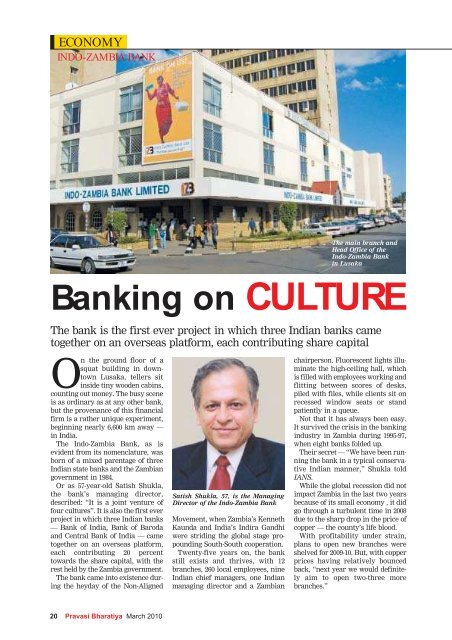
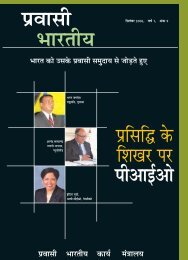



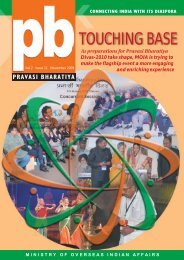
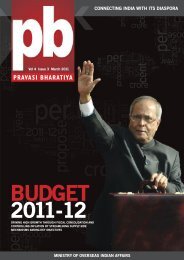

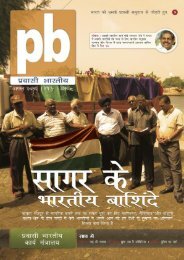
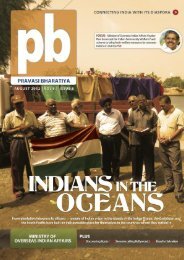
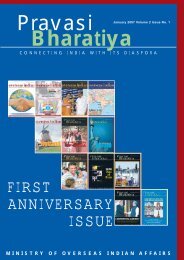


![flaxkiqj feuh izoklh Hkkjrh; fnol] vDVwcj 9&11 - Overseas Indian](https://img.yumpu.com/43977040/1/184x260/flaxkiqj-feuh-izoklh-hkkjrh-fnol-vdvwcj-911-overseas-indian.jpg?quality=85)
